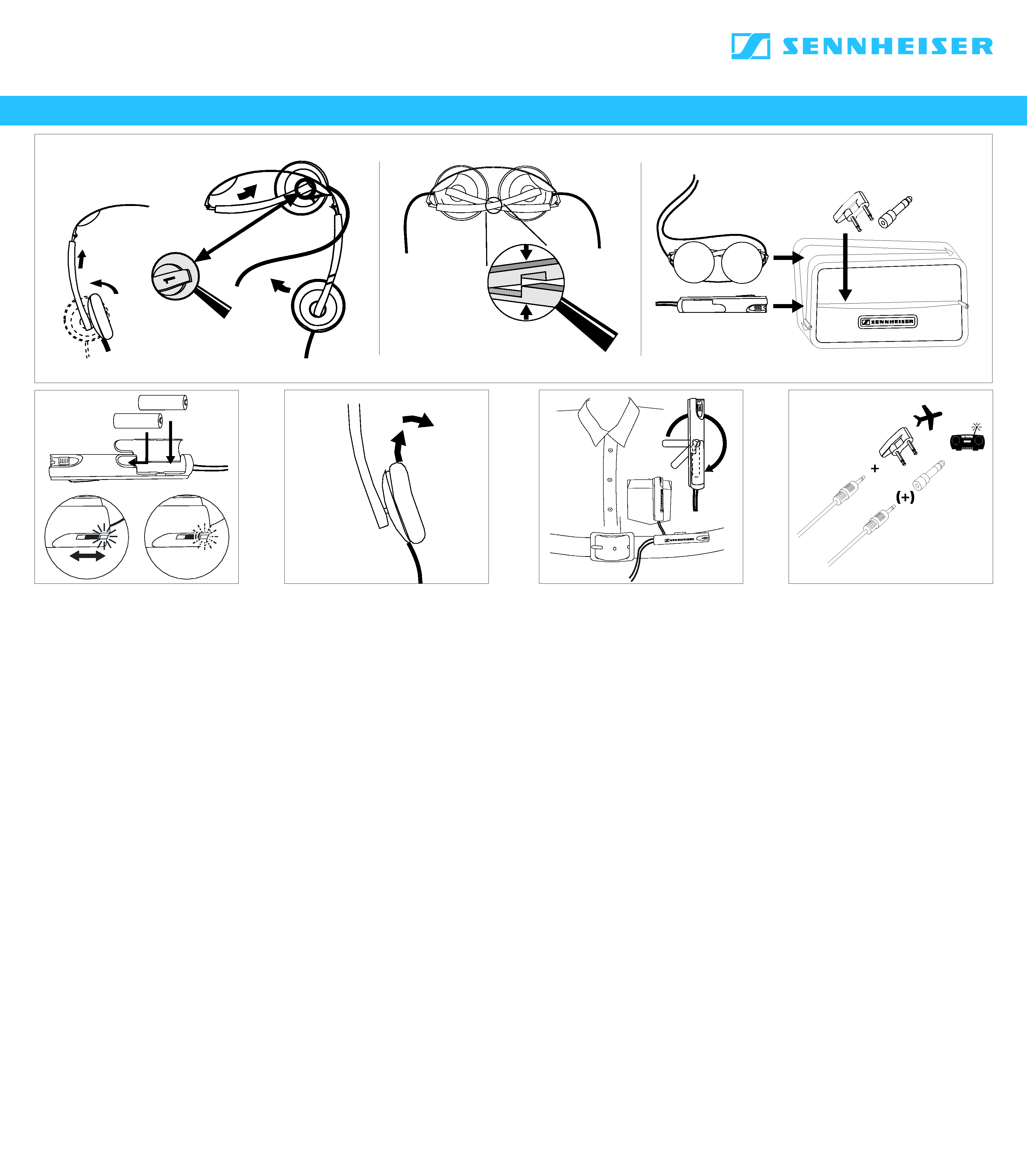
Français - Ecouteurs de voyage PXC 250
Moins de stress grâce à moins de bruits. Les bruits environnants, par ex. le bruit du moteur
au cours de longs trajets aériens, contribuent à amener beaucoup trop de stress et de
fatigue. Le PXC 250 réduit ces bruits grâce à sa structure fermée et sa compensation active
des bruits NoiseGardTM, que vous pouvez activer en cas de besoin (ON). La technologie
NoiseGardTM a été développée par Sennheiser et est aujourd'hui utilisée dans le monde
entier dans de nombreux cockpits.
NoiseGardTM contre les bruits environnants
La compensation active des bruits NoiseGardTM est basée sur le principe de la suppression
des sons complexes en basse fréquence grâce à des contre-sons (sons à phases inversées).
Des microphones minuscules captent à cet effet les bruits environnants. L'électronique
NoiseGardTM génère ensuite une onde sonore dont la phase est décalée de 180° avec le son
parasite - cela provoque la quasi-suppression mutuelle des deux ondes sonores. Le signal
musical est en conséquence rendu pratiquement sans être modifié.
AVERTISSEMENT: Evitez d'utiliser le casque à fort volume de façon prolongée, vous
risqueriez de provoquer des lésions irréversibles de votre système auditif. Il est
recommandé de maintenir le volume à un niveau modéré. Pour votre propre sécurité,
n'utilisez pas le casque en conduisant ou à bicyclette.
Employez uniquement des piles alcalines dans votre casque NoiseGard. Si, pendant
l'utilisation du NoiseGard, vous entendez un grésillement, ou des trous dans la modulation,
nettoyez les contacts des piles sur une surface légèrement abrasive
Eléments livrés
Ecouteurs PXC 250, fiche jack 6,35 mm, adaptateur pour monofiche double 3,5 mm, étui,
mode d'emploi.
Caractéristiques techniques
Principe du convertisseur (écouteur) dynamique, fermé
Impédance nominal
300
Réponse en fréquence (écouteur)
8.....21500 Hz
Jack
3,5 mm stéréo
Couplage oreille
supra-aural
Poids sans câble
env. 65 g
SPL á 1 kHz 1 Veff
107 dB
Longueur du câble
1,8 m
Distorsion harmonique pour 1 kHz
< 0,1 %
Garantie
2 ans
Italiano - Cuffie da viaggio PXC 250
Meno stress con meno rumore. I rumori ambientali, come il rumore dei motori durante
lunghi viaggi in aereo contribuiscono molto allo stress e all'affaticamento. PXC 250 riduce
questo rumore grazie alla sua struttura chiusa e al sistema attivo di compensazione del
rumore NoiseGardTM,
attivabile in caso di necessità (ON). La tecnologia NoiseGardTM è stata sviluppata da
Sennheiser ed è oggi utilizzata in diverse cabine di pilotaggio.
NoiseGardTM contro i rumori ambientali
Il sistema attivo di compensazione del rumore NoiseGardTM si basa sul principio
dell'estinzione del suono nel campo a bassa frequenza grazie ad un controsuono (suono di
fase inversa). Minuscoli microfoni catturano a tale scopo i rumori ambientali. L'elettronica
NoiseGardTM produce quindi un'onda sonora che viene sfasata di 180° in un rumore di
disturbo, con il risultato che le due onde sonore si annullano quasi completamente a
vicenda. Il segnale musicale viene invece riprodotto quasi immutato.
ATTENZIONE: l fine di prevenire danni al vostro udito, vi consigliamo di evitare di usare la
cuffia ad un volume elevato per un lungo periodo di tempo. E' consigliabile mantenere il
volume ad un livello moderato. Per la vostra sicurezza, vi consigliamo di non usare la cuffia
mentre siete alla guida di auto e moto.
Esistono batterie di diversa qualità. Se durante il funzionamento in NoiseGard si dovessero
avvertire scricchiolii, fruscii o subire interruzioni, questo potrebbe dipendere dalle superfici
di contatto delle batterie. Strofinare brevemente le superfici di contatto e inserire
nuovamente le batterie.
Fornitura
Cuffia PXC 250, spina jack 6,35 mm, adattatore per doppia presa mono 3,5 mm, astuccio,
istruzioni per l'uso.
Caratteristiche tecniche
Omzetprincipe (hoofdtelefoon)
dynamisch, gesloten Nominale impedantie
300
Audio-overdrachtsgebied (hoofdtelefoon) 8......21500Hz
Jackplug
3,5 mm stereo
Koppeling aan het oor
op het oor liggend
Gewicht zonder kabel
ca. 65 g
Geluidsniveau bij 1 kHz 1 Veff
107 dB (SPL)
Kabellengte
1,8 m
Vervormingsfactor bij 1 kHz
< 0,1 %
Garantie
2 jaar
Nederlands - Reishoofdtelefoon PXC 250
Minder stress door minder lawaai. Omgevingslawaai, b.v. het motorgeluid tijdens een lange
vliegreis, leidt tot veel stress en vermoeidheid. De PXC 250 reduceert dit lawaai door zijn
gesloten bouwwijze en het actieve lawaai-onderdrukkingssysteem NoiseGardTM, die u
indien nodig kunt inschakelen (ON). De NoiseGardTM technologie werd ontwikkelt door
Sennheiser en wordt vandaag wereldwijd ingezet in vele cockpits.
NoiseGardTM tegen omgevingslawaai
Het actieve lawaai-onderdrukkingssysteem NoiseGardTM is gebaseerd op het principe van
uitschakeling van geluid in het diepfrequente gebied door het gebruik van "tegenfase"
geluid. Daartoe nemen uiterst kleine microfoons het omgevings-lawaai op. De NoiseGardTM
elektronica wekt dan een geluidssignaal op, dat exact 180° in fase is verschoven ten
opzichte van het stoorsignaal - zodat beide geluidsignalen elkaar bijna opheffen. Het
muzieksignaal wordt daarentegen bijna ongewijzigd weergegeven.
WAARSCHUWING: Te lang luisteren met een te hoog volume kan gehoorschade
veroorzaken. Niet in het wegverkeer gebruiken!
Er zijn verschillende soorten batterijen verkrijgbaar. Wanneer u in de NoiseGuard-werking
gekraak en gekras hoort of het geluid valt weg, kan dat aan de contactvlakken van de
batterijen liggen. Wrijf even over de contactvlakken van de batterijen en plaats ze weer in
het batterijvak.
Leveromvang
Hoofdtelefoon PXC 250, jackplug 6,35 mm, adapter voor dubbele
monobus 3,5 mm, etui, gebruiksaanwijzing
Technische gegevens
Trasduttore (cuffia)
dinamico, chiuso
Impedenza nominale
300
Risposta in frequenza (cuffia)
8.....21500 Hz
Spina jack
3,5 mm stereo
Adattamento all'orecchio
appoggio sull'orecchio
Peso senza cavo
ca. 65 g
Pressione acustica a 1 kHz 1 Veff
107 dB (SPL)
Lunghezza cavo
1,8 m
Fattore di distorsione a 1 kHz
< 0,1 %
Garanzia
2 anni
Español - Auriculares de viaje PXC 250
Menos estrés, evitando el ruido. El ruido existente en el ambiente, por ejemplo el ruido de
los motores durante largos vuelos, ocasiona gran estrés y cansancio. Gracias a su ejecución
cerrada y a la compensación activa de ruidos NoiseGardTM, que puede usted conectar en caso
necesario (ON), el PXC 250 disminuye el ruido. La tecnología NoiseGardTM desarrollada por
Sennheiser se utiliza hoy en día en muchos cockpits.
NoiseGardTM contra el ruido ambiental
La compensación activa de ruidos NoiseGardTM se basa en el principio de la supresión del
sonido en la gama de bajas frecuencias por medio de la reducción de sonido (sonido de fase
inversa). A tal fin, diminutos micrófonos captan el ruido ambiente. La electrónica
NoiseGardTM genera entonces una onda acústica, desfasada en 180° respecto al ruido - de
ello resulta que, por efecto recíproco, las dos ondas acústicas se suprimen casi por completo.
Por el contrario, la reproducción de la señal musical tiene lugar casi sin modificación alguna.
PRECAUCIÓN: Evitar el uso de audífonos con niveles de volumen alto por periodos largos de
tiempo. Hacerlo puede dañar su audición. Es recommendable mantener un nivel de volumen
moderado en todo momento. Por su propia seguridad, no lo use mientras conduce o en
bicicleta.
Existen baterías de distintas calidades. Si durante el funcionamiento percibiera ruidos de
interferencias, zumbido o hubiera interrupciones, podrían estar causados por las zonas de
contacto de las baterías. Frote ligeramente las zonas de contacto y vuelva a introducir las
baterías.
Volumen de suministro
Auricular PXC 250, jack de 6,35 mm, adaptador para casquillo doble monofónico de 3,5 mm,
estuche, instrucciones de manejo
Datos técnicos
Principio transductor (auricular)
dinámico, cerrado
Impedancia nominal
300
Gama de transmisión de audio (auricular)
8.....21500 Hz
Jack
3,5 mm estéreo
Acoplamiento al oído
sob. el pab. aur.
Peso sin cable
aprox. 65 g
Presión sonora a 1 kHz 1 Veff
107 dB (SPL)
Largo del cable
1,8 m
Factor de distorsión a 1 kHz
< 0,1 %
Garantía
2 años
Sennheiser electronic GmbH & Co. KG 30900 Wedemark, Germany
www.sennheiser.com
Printed in China
Publ. 08/04
85364/A04
PXC 250









